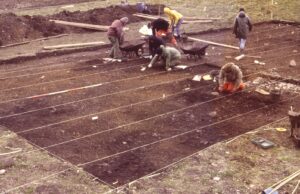
I’ve been wondering about the archaeological footprint of the lockdown.
Right now, it impacts on everyone across the United Kingdom. No one is untouched by it. It is a big event globally. But will it be visible to archaeologists in a few centuries time – what about millennia? I’ve always been fascinated with the chronological distortion of relative values. The idea that the flint tools we find so significant may hardly have figured to the average Mesolithic hunter because they were not the primary goods required for everyday life, nor did they necessarily help you to acquire status. Even the way in which we lump all stone tools together is a modern concept. You and I would not regard a fork and a screwdriver in the same way, and yet they share many traits in common. Archaeology can distort events into becoming more or less significant.
So, lockdown…
So much is imperceptible. Around my house the footpaths all show signs of increased passage. But none have yet been repaired in an archaeologically visible way. Deposition at the recycling centre has stopped: there are some instances of fly tipping. But then there are always some instances of fly tipping. There will no doubt be more recyclables in the ‘normal’ rubbish bags – but all of our rubbish here is incinerated at high temperature in Shetland. There is certainly less traffic on the roads, but it is hard to prove an absence. Cooking and baking are on the rise, possibly providing some interesting information for the more forensic archaeologists of the future. Gardening is very popular, perhaps it will be possible to model the dating of enlarged vegetable beds and new garden features with accuracy enough to suggest correlation. Houses have hardly changed, though most of our communal buildings stand empty – that will surely have an impact if it goes on for long enough. There are, of course, the new hospitals, by and large repurposed from other structures. That will leave an imprint, even as they return to their original uses. And finally, increased burials. While mass graves have been necessary in some countries, exigencies of space and custom in many places mean that twenty-first century burial rarely affords a handle for the unfortunate archaeologist of the future. In this I am at one with my Mesolithic forebears, they were equally uncaring about future research.
What else would you notice? I am very much aware of increasing number of small green and blue bags littering the countryside. While most dog owners are responsible and take the offerings of their pets home, some clearly see lockdown as an excuse to relax their vigilance. I hate to think that we could collectively become defined by dog faeces. We are certainly using more plastics once more; I can only hope that this will not lead to increased microplastics in rivers and oceans, though I do fear the consequences. I’m guessing that many houses, my own included, currently have small deposits of glass and tins, steadily growing as we seek comfort in the odd wee dram or gin and tonic. My plan is to get rid of this evidence at the tip as soon as it reopens.
So, on balance, my thoughts just now suggest that the covid-19 pandemic will hardly figure in the archaeological annals of the future.
And yet; there are signs that the long-term footprint may be bigger than we think. There is much speculation about the ways in which life and society around the globe will have to change as we come to terms with this newcomer competing for global dominance. Social distancing; altered transportation; different education, shopping, and medicine; even a notable variation in the way we dress. Architecture will, on all fronts, change; townscapes will be different. We may even have to become accustomed to new ways of socialising. It is hard to anticipate the precise physical changes this will bring about, just as no one in the early twentieth century anticipated the extent of tarmacadam and air pollution that would come with the adoption of motorized transport. Though it is also important to remember that change is a sign of affluence. How much will the lifestyle of those in shanty towns, or refugee camps, be impacted I wonder. Adaptions to a post-covid lifestyle seem almost luxurious in some situations.
My question is, therefore, whether it will be possible to discern the tipping point. What led to this change? Points of transformation have always been fascinating for archaeologists, just look at the emotion and energy expended on analysis of the arrival of farming. It is notoriously difficult to define with any clarity the precise point and reasons why a whole lifestyle might have swung from one focus to another. If the identifiable remains of our tipping point comprise increased deposits of canine faeces, plastic waste, and human burials, along with repurposed gardens and richer human waste then I am rather worried that they might be misinterpreted.
You must be logged in to post a comment.